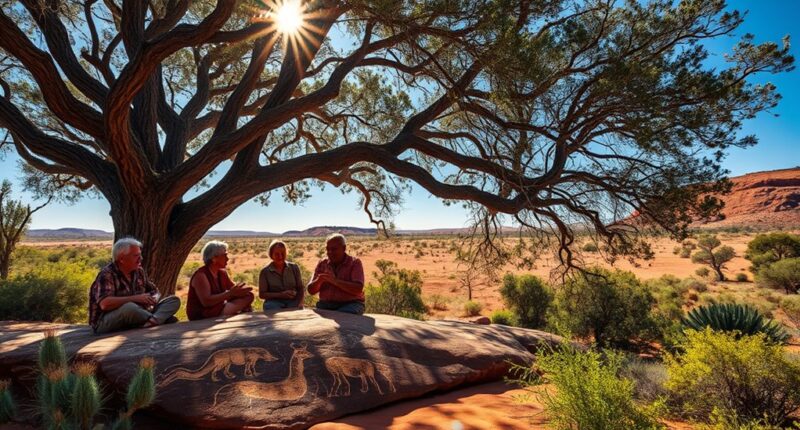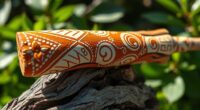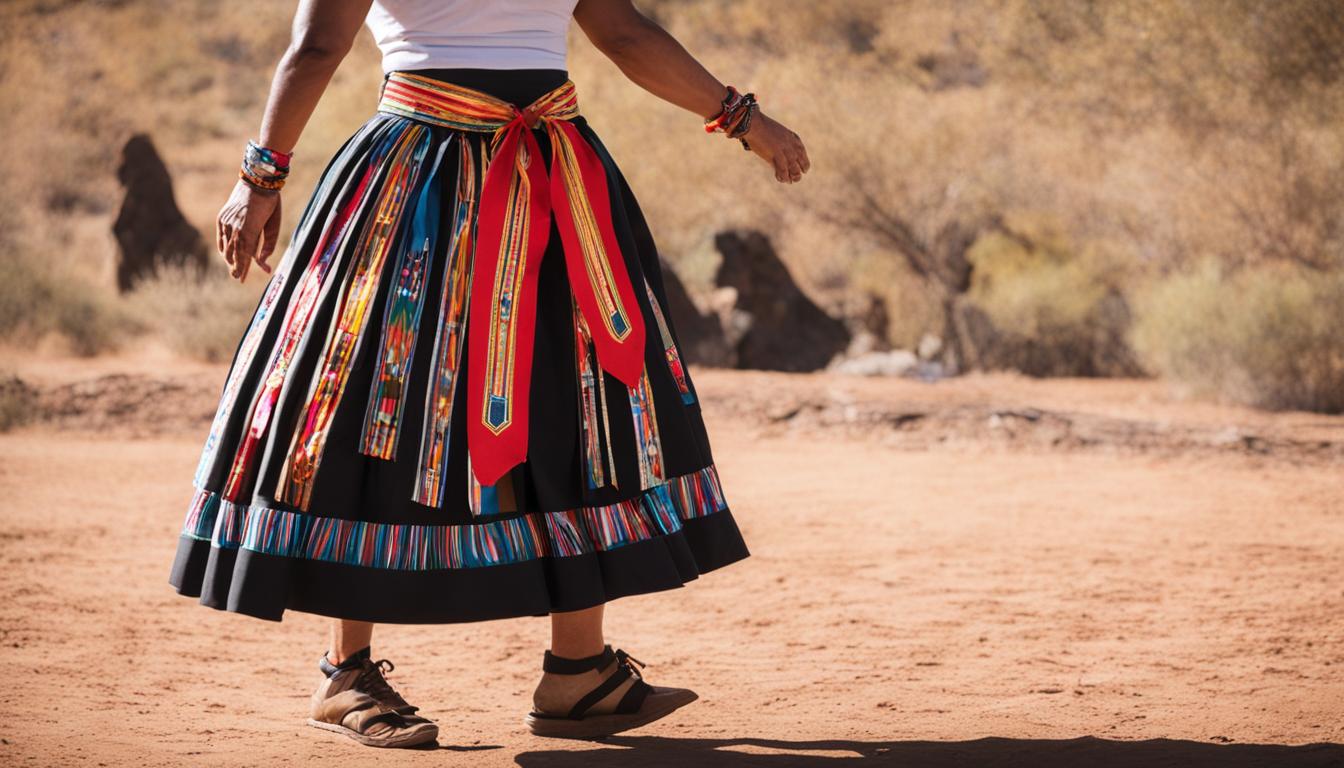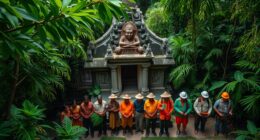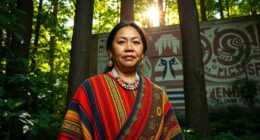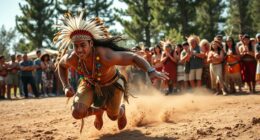You see, Aboriginal storytelling encodes essential ecological knowledge through vivid narratives, songs, and ceremonies, passing down insights about land, water, animals, and seasonal changes across generations. These stories act as living maps, highlighting animal behaviors and sustainable practices embedded in cultural traditions. By preserving ecological details vividly in cultural expressions, these stories guarantee the knowledge remains relevant and resilient for millennia. If you look further, you’ll discover how this timeless method continues to support ecological understanding today.
Key Takeaways
- Stories encode ecological information about animal behaviors, migration patterns, and seasonal changes, serving as living ecological maps.
- Oral traditions transmit vital environmental knowledge across generations, maintaining ecological data without written records.
- Mythologies and ceremonies embed ecological insights, guiding resource use and conservation practices sustainably.
- High visual accuracy in storytelling preserves ecological details, ensuring vivid and memorable knowledge transmission over millennia.
- Cultural resilience through storytelling sustains community identity and environmental understanding despite external pressures.
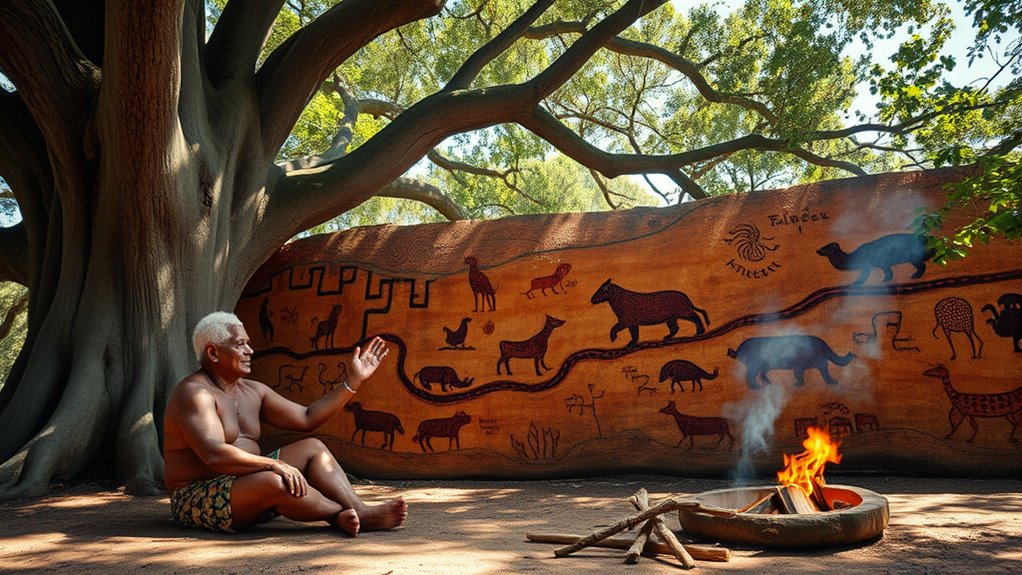
Aboriginal storytelling weaves together cultural traditions and ecological knowledge, serving as an essential way for communities to pass down their understanding of the environment. These stories are more than mere tales; they are living records that embody centuries of interaction with the land, water, and wildlife. As you listen or learn, you realize that each narrative carries deep insights into local ecosystems, highlighting patterns of animal behavior, seasonal changes, and sustainable resource use. This oral tradition fosters cultural resilience, enabling communities to maintain their identity and values amid external pressures and environmental changes. Your awareness grows that storytelling isn’t just about entertainment—it’s a crucial method for preserving environmental knowledge across generations, particularly in regions where written records are scarce.
Through these stories, you understand that Aboriginal communities encode critical ecological data into mythologies, songs, and ceremonies. For example, a story about a specific animal may reveal its migration patterns, breeding habits, or preferred habitats, guiding community members on when and where to harvest or avoid certain resources. This embedded environmental knowledge becomes a living map, adaptable to current conditions yet rooted in ancestral wisdom. Such stories also serve as warnings or lessons, teaching future generations how to live sustainably within their ecological context. You see that this approach enhances cultural resilience, reinforcing the community’s ability to adapt and thrive despite environmental shifts or threats. Additionally, the high color accuracy of traditional storytelling elements ensures that the vividness of these ecological details is preserved across generations.
Frequently Asked Questions
How Do Aboriginal Stories Evolve Over Generations?
You observe that Aboriginal stories evolve over generations through active cultural resilience and knowledge transmission. As stories are shared orally, they adapt to new contexts while preserving core lessons. This dynamic process guarantees that cultural values and ecological knowledge stay relevant, allowing communities to maintain a living connection to their environment. Over time, storytelling becomes a flexible tool for passing down important ecological data, safeguarding it across generations.
Can Non-Indigenous People Access or Learn From These Stories?
You can access and learn from Aboriginal stories through respectful cultural exchange and educational programs. Many communities welcome sharing their knowledge, fostering understanding and appreciation. While some stories are sacred and may be protected, others are shared openly, promoting knowledge accessibility. By approaching with respect and openness, you help preserve these valuable narratives, gaining insights into ecological practices and cultural values that have endured for generations.
What Technologies Complement Storytelling in Ecological Preservation?
You can enhance ecological preservation by using technologies like digital mapping and community databases alongside storytelling. Digital mapping visualizes traditional knowledge geographically, helping you understand ecosystems better. Community databases store stories and ecological data securely, making it accessible for future generations. These tools complement storytelling by preserving, sharing, and analyzing ecological knowledge, ensuring that Indigenous wisdom continues to inform conservation efforts for generations to come.
How Do Oral Traditions Compare to Written Ecological Records?
You see, oral traditions often excel in cultural resilience, passing down ecological knowledge through generations. Unlike written records, they rely on vivid storytelling that maintains narrative accuracy over time. You might find that these stories adapt, enriching their meaning while preserving core ecological facts. This dynamic form of knowledge transfer keeps ecological data alive, emphasizing community connection and cultural continuity that written records sometimes lack.
Are There Risks in Interpreting Aboriginal Stories Outside Their Cultural Context?
Imagine stumbling upon Aboriginal stories without understanding their cultural context—you risk cultural misinterpretation and introducing historical inaccuracies. You might wrongly interpret symbols or lessons, which can distort their true ecological insights. It’s essential to respect the cultural nuances embedded in these stories, as misreading them not only risks losing critical ecological knowledge but also disrespects the community’s traditions. Always approach with sensitivity and seek cultural guidance when interpreting these stories.
Conclusion
By listening to Aboriginal storytelling, you tap into a wisdom so ancient, it could reshape your entire understanding of the universe. These stories aren’t just tales—they’re living archives holding ecological secrets for millennia, more enduring than any modern record. If you embrace this knowledge, you might just disclose the key to saving our planet, because sometimes, the oldest stories carry the power to change the future itself—if only you’re willing to listen.
Mary is a passionate writer who brings creativity and a fresh perspective to our team. Her words have the power to captivate and inspire, making her an essential contributor to our content. Mary’s commitment to storytelling and dedication to promoting Indigenous culture ensures that her work touches the hearts of our readers. We’re fortunate to have her as part of our team.
